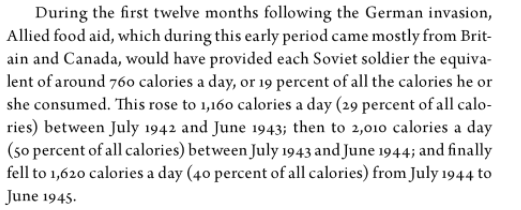They would've been catastrophic no later then 1943, as that's when Food production reached it's lowest extent and Lend Lease compromised 50% of the RKKA's ration strength:
The Bread of Affliction: The Food Supply in the USSR during World War II, by William Moskoff -
"The central fact behind the increased importance of the collective farm market was the drastic drop in food production, especially in 1942 and 1943, and the diminished proportion that went to the civilians. In 1943 overall agricultural production was only 38 percent of the 1940 level. In 1943, however, the Red Army began to recapture agricultural areas of the Ukraine, Belorussia, and the Caucasus and by the next year, 1944, agricultural output had risen to 54 percent of the 1940 level. Not surprisingly, the collapse of the food economy led to astonishing increases in prices. The most rapid
rate [Emphasis by author] of increase in prices took place in 1942 and began to taper off in mid-1943."
The Soviet Economy and the Red Army, 1930-1945, by Walter Scott Dunn
-
"By November of 1941, 47% of Soviet cropland was in German hands. The Germans had 38% of the grain farmland, 84% of the sugar land, 38% of the area devoted to beef and dairy cattle, and 60% of the land used to produce hogs. The Russians turned to the east and brought more land into cultivation. In the fall of 1941, the autumn and winter crops increased sharply in the eastern area. But despite all efforts, farm yields dropped from 95.5 million tons of grain in 1940 to 29.7 million tons in 1942. Production of cattle and horses dropped to less than half of prewar levels and hogs to one fifth. By 1942, meat and dairy production shrank to half the 1940 total and sugar to only 5%. Farm production in 1942 and 1943 dropped to 38% and 37% of 1940 totals."
Mark Harrison also considers Lend Lease vital to preventing a general collapse in the USSR, and Stalin did likewise agree at the time.

